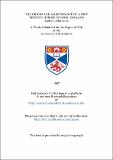The origin and maintenance of a new 'Senecio' hybrid in York, England
Abstract
The principal aim of the research presented in this thesis was to use a broad range of analytical techniques to investigate the origin and maintenance of a newly arisen Senecio hybrid, referred to as York radiate groundsel, in York, England. The results of morphological and molecular analyses, showed that York radiate groundsel is a hybrid product between Senecio vulgaris var. vulgaris L. and S. squalidus L, and is distinct from the stabilized introgressant, S. vulgaris var. hibernicus Syme. These findings also indicated that York radiate groundsel is unlikely to be a first generation hybrid, but has probably undergone limited backcrossing to S. vulgaris with current populations of the plant derived from a single origin. Tetraploid hybrid progeny between S. squalidus and S. vulgaris were synthesized artificially and some were partially fertile and similar in morphology to York radiate groundsel. It was argued that unreduced S. squalidus gametes are moer likely to have been involved in the origin of the new hybrid. Postzygotic breeding barriers were shown to exist between York radiate groundsel and both of its parents. Backcrosses to S. squalidus were triploid and highly sterile, while backcrosses to S. vulgaris were tetraploid, but exhibited a significant reduction in seed and pollen fertility in the subsequent generation. Although flowering time of York radiate groundsel and S. vulgaris differed substantially, an examination of capitula number in relation to flowering time, revealed that the flowering time difference was probably not selected as a prezygotic isolating mechanism. The results of a field experiment that measured outcrossing rates, suggested that York radiate groundsel may be more attractive to pollinators than either variety of S. vulgaris, which would in turn, lead to its effective ethological reproductive isolation from these taxa. It was also shown that characters that could promote pollinator attraction in the new hybrid, have probably been inherited from S. squalidus and have remained associated with the ray floret locus in York radiate groundsel due to gene linkage. The effects of inbreeding on fitness were found to be negligible in York radiate groundsel and this, together with the fact that it exhibited some novel ecological characteristics, is discussed in regard to its continued maintenance in the wild. The distinctive morphological and molecular phenotype of York radiate groundsel and the fact that it has achieved a level of reproductive isolation from both of its parents, should favour its recognition as a new species.
Type
Thesis, PhD Doctor of Philosophy
Collections
Items in the St Andrews Research Repository are protected by copyright, with all rights reserved, unless otherwise indicated.

